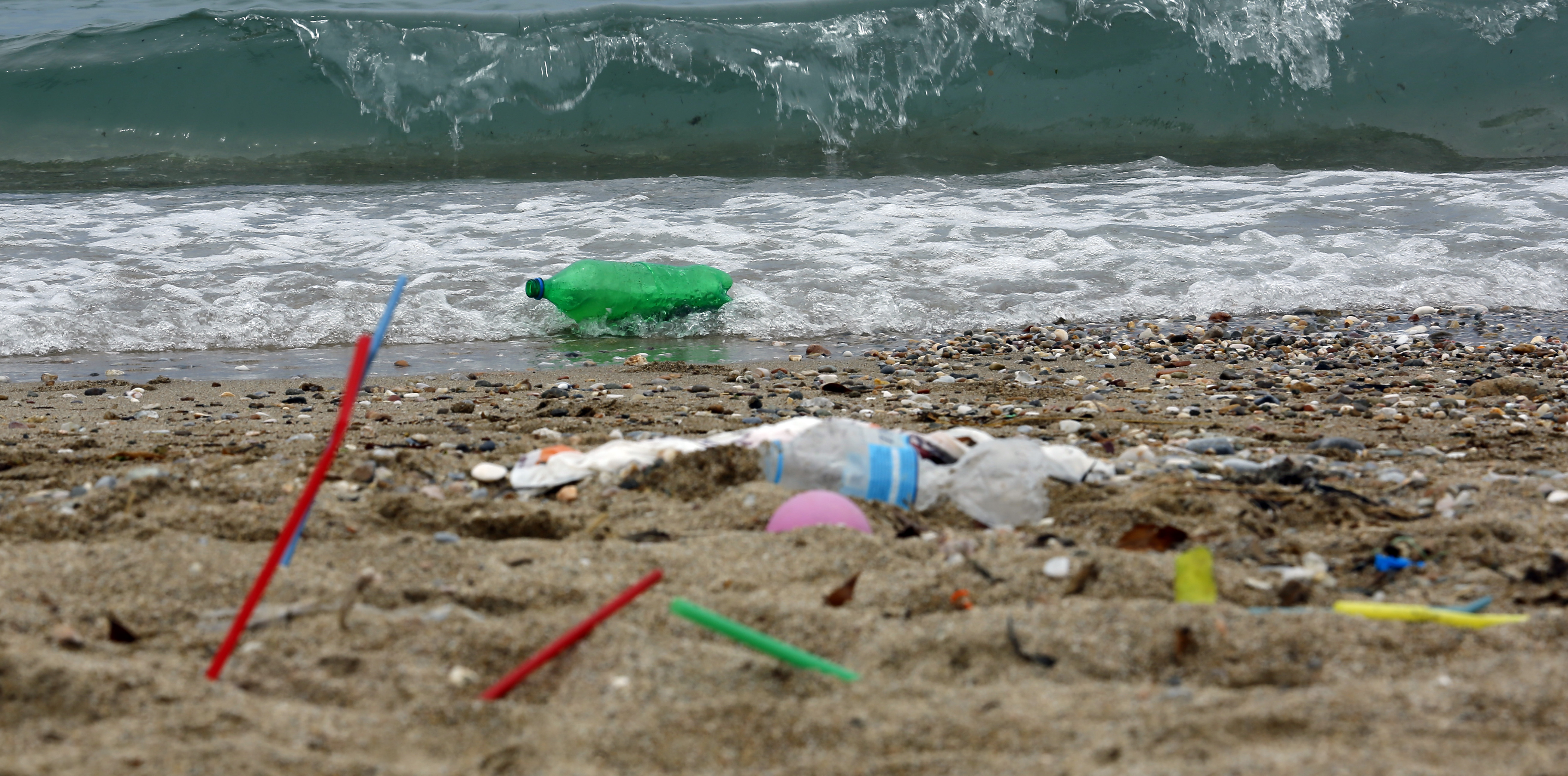Our plastic oceans
One day soon, there will be more plastic in the ocean than fish

What happens after an endless supply of plastic in consumer products winds up in the sea? Here's everything you need to know:
How bad is the pollution?
A garbage truck's worth of plastic enters the world's oceans every minute. All told, humanity has dumped up to 14 million tons of plastic pollution into the seas, and bits of it can be found from the water's surface down to its most extreme depths. You wouldn't know it looking over the side of a ship, since much of the waste has been broken down by waves and ultraviolet light into microplastics, particles often as small as a millimeter wide. But when researchers in 2015 analyzed more than a million pieces of trash in the Pacific, 99.9 percent of it was plastic. Scientists have no idea how long that will take to degrade — perhaps hundreds of years, if ever. By 2050, according to the World Economic Forum, there will be more plastic, by weight, in the ocean than fish.
The Week
Escape your echo chamber. Get the facts behind the news, plus analysis from multiple perspectives.

Sign up for The Week's Free Newsletters
From our morning news briefing to a weekly Good News Newsletter, get the best of The Week delivered directly to your inbox.
From our morning news briefing to a weekly Good News Newsletter, get the best of The Week delivered directly to your inbox.
Where's it coming from?
Since plastic became incorporated into many consumer products in the 1950s, only about 21 percent has been recycled or incinerated. What makes plastic appealing — that it's not only cheap and versatile but also virtually indestructible — makes it a nightmare to dispose of, and about 3 percent of the plastic produced in coastal countries eventually enters the ocean. Fishing nets and other plastic fishing gear are a major source. So is lightweight plastic litter, which can be blown off garbage trucks, barges, and landfills, or deliberately dumped into rivers or sewer systems and carried out to sea. Many of the worst polluters are developing countries with rudimentary waste-management systems. China bears the greatest responsibility, accounting for about 30 percent of the global total, while the United States ranks 20th. A less obvious form of plastic pollution comes from microparticles found in products such as deodorant, toothpaste, and sunscreen that wash down drains. Many clothes are made with synthetic fibers, and one wash cycle can cause 200,000 fibers to escape into wastewater. As a consequence, the Hudson River in New York, for example, dumps about 150 million plastic fibers into the ocean every day.
Where does it all go?
A lot of it winds up in five huge masses of plastic debris, called gyres, created by currents in the world's oceans. The largest of these swirling plastic stews is the Great Pacific Garbage Patch, formed by winds and currents between California and Hawaii. It's twice the size of Texas and "increasing exponentially," according to a study published earlier this year. A plastic patch along the North Atlantic between Virginia and Cuba is nearly as large. These five gyres cover as much as 40 percent of the planet's ocean surface. To clean up all five would take 1,000 boats filtering the water 24 hours a day for 79 years.
A free daily email with the biggest news stories of the day – and the best features from TheWeek.com
Is it affecting marine life?
Yes, though the impact is not well understood. The Convention on Biological Diversity counts 663 species affected by plastic pollution in the ocean. Researchers find that fish raised in waters with heavy concentrations of microplastics are "smaller, slower, and more stupid" than normal fish. For some sea creatures, the impact is more obvious and immediate: In June, after a struggling whale died in a Thai canal, its stomach was found to contain 17 pounds of plastic, including 80 shopping bags, which had prevented the whale from digesting food. Fish, mammals, and birds dead from a similar cause are washing up on beaches around the world.
Are humans at risk?
The evidence is unclear. The polymers in plastics are chemically inert, but some common additives in plastic behave similarly to human hormones, and might do damage in high concentrations. And it's becoming increasingly difficult not to ingest plastics. A study last year found 83 percent of the world's drinking water is contaminated, while this year, researchers found 93 percent of bottled water contains some plastic, often double the amount found in tap water. Seafood also often contains plastic. "I think we'll find all sorts of unintended consequences," said Ronald Geyer, an industrial ecologist at the University of California, Santa Barbara. "I'd be very surprised to find out that it is a purely aesthetic problem."
What's being done?
There are growing efforts here and abroad to use less plastic, such as the #StopSucking campaign to get rid of disposable plastic straws, and municipal laws banning plastic bags. Unfortunately, the environmental net gain of such efforts is small, and scientists agree that effective remedies to plastic pollution will require global cooperation. The European Union launched a "plastics strategy" this year that aims to make all plastic packaging recyclable by 2030. But at the G-7 summit in June, the U.S. and Japan refused to support a declaration on climate change that included targets on curbing plastic pollution, fearing its impact on their economies.
Reversing the damage
Purging the ocean of plastic sounds like an all but impossible task, given that there are trillions of nanoparticles dispersed in the water, yet there's no shortage of proposals to do just that. A 23-year-old Dutch environmentalist named Boyan Slat has raised more than $30 million for a project called The Ocean Cleanup, which will deploy long floating barriers that he says can trap and remove half of the plastic in the Great Pacific Garbage Patch within five years. Scientists, however, fear the effect of Slat's design on sea animals and zooplankton living close to the surface. Researchers in Europe have discovered that the greater wax moth produces larvae capable of degrading polyethylene, which makes up 40 percent of plastics. If that enzyme were harvested, it could be produced on an industrial scale to break down plastics in landfills and the ocean. Others have proposed sucking up ocean plastics with marine drones, waterborne kites, or artificial underwater drains, though these ideas have met with plenty of skepticism. In the meantime, people can chip away at pollution the old-fashioned way. Every year on Coastal Cleanup Day, hundreds of thousands of volunteers in more than 100 countries pick up about 20 million pounds of trash on shorelines, much of it plastic.
-
 China’s single mothers are teaming up
China’s single mothers are teaming upUnder the Radar To cope with money pressures and work commitments, single mums are sharing homes, bills and childcare
-
 Employees are branching out rather than moving up with career minimalism
Employees are branching out rather than moving up with career minimalismThe explainer From career ladder to lily pad
-
 ‘It is their greed and the pollution from their products that hurt consumers’
‘It is their greed and the pollution from their products that hurt consumers’Instant Opinion Opinion, comment and editorials of the day
-
 Femicide: Italy’s newest crime
Femicide: Italy’s newest crimeThe Explainer Landmark law to criminalise murder of a woman as an ‘act of hatred’ or ‘subjugation’ but critics say Italy is still deeply patriarchal
-
 Brazil’s Bolsonaro behind bars after appeals run out
Brazil’s Bolsonaro behind bars after appeals run outSpeed Read He will serve 27 years in prison
-
 Americans traveling abroad face renewed criticism in the Trump era
Americans traveling abroad face renewed criticism in the Trump eraThe Explainer Some of Trump’s behavior has Americans being questioned
-
 Nigeria confused by Trump invasion threat
Nigeria confused by Trump invasion threatSpeed Read Trump has claimed the country is persecuting Christians
-
 Sanae Takaichi: Japan’s Iron Lady set to be the country’s first woman prime minister
Sanae Takaichi: Japan’s Iron Lady set to be the country’s first woman prime ministerIn the Spotlight Takaichi is a member of Japan’s conservative, nationalist Liberal Democratic Party
-
 Russia is ‘helping China’ prepare for an invasion of Taiwan
Russia is ‘helping China’ prepare for an invasion of TaiwanIn the Spotlight Russia is reportedly allowing China access to military training
-
 Interpol arrests hundreds in Africa-wide sextortion crackdown
Interpol arrests hundreds in Africa-wide sextortion crackdownIN THE SPOTLIGHT A series of stings disrupts major cybercrime operations as law enforcement estimates millions in losses from schemes designed to prey on lonely users
-
 China is silently expanding its influence in American cities
China is silently expanding its influence in American citiesUnder the Radar New York City and San Francisco, among others, have reportedly been targeted